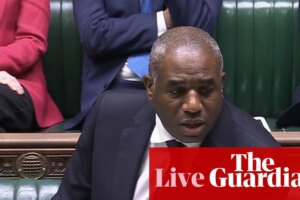
Australia’s rich deposits of minerals used for green energy technologies and military hardware are increasingly prized, especially because of rising anxiety about China’s stranglehold on the global supply chain.
That anxiety escalated after Beijing imposed new restrictions on rare earths exports, prompting a furious rebuke from Donald Trump and a warning from his treasury secretary that western allies would need to “decouple” from China if it proved an unreliable supplier.
The timing of the latest US-China trade conflict could be good for Anthony Albanese, who will arrive at next week’s White House meeting armed with a valuable bargaining chip to negotiate with the deal-making president.
The Australian government is expected to offer the US access to a proposed critical minerals stockpile, amid wider attempts to shield the country from the worst of Trump’s trade strikes and secure the Aukus submarine deal.
But one expert thinks the critical minerals fight puts Australia in a “really compromised position”, caught between the competing priorities of its strongest strategic ally and its biggest trading partner.
Why is the US so desperate for critical minerals?
Such critical minerals are the raw materials used in batteries, solar panels, wind turbines and military weapons.
Australia mines roughly half of the world’s lithium – a critical ingredient for EV batteries – and about a quarter of global bauxite, along with vast amounts of cobalt, manganese and a subset of critical minerals, known as rare earths. The overwhelming majority of these resources are exported overseas – mostly to China – rather than refined, processed and manufactured into finished products domestically.
Australia is not alone on that front.
Rare earths: how these critical minerals impact Australian industry and global politics – video
China controls about 70% of rare earth mining and 90% of processing, allowing it to manipulate global supply and prices.
The US has been desperate to break China’s market domination to guarantee a secure supply of the essential materials.
Susan Park, a University of Sydney professor who specialises in the global energy transition, says the US relies on China for more than half of the 50 resources on its critical minerals list, including metals used for aircraft, submarines and drones.
“The US wants to maintain its military dominance, and so it’s realised that it absolutely has to get rare earth elements from somewhere that it does not believe it is in geo-strategic competition with,” she says.
A close ally with an abundance of the raw materials, Australia is an obvious partner.
“We know that American companies desperately need critical minerals, and Australia is very well placed to service that need,” said the treasurer, Jim Chalmers, who is in Washington before Albanese’s visit.
What can Australia offer – and would it actually help?
Speculation about a possible critical minerals deal before the Trump-Albanese meeting has focused on granting the US access to the government’s proposed $1.2bn domestic stockpile.
The “critical minerals strategic reserve” was announced in April, as part of Albanese’s immediate response to Trump’s so-called Liberation Day tariffs, but details remain scarce while the government consults with industry on its design.
A discussion brief circulated to industry stakeholders in recent weeks by the Department of Prime Minister & Cabinet (PM&C), seen by Guardian Australia, says the stockpile will “secure access to a small set of critical minerals with high strategic value for the reserve”.
The brief asks for suggestions on which minerals would be “suitable” for the reserve in the next two, five and 10 years, indicating decisions about the material to be stockpiled have yet to be made.
Government and industry sources familiar with the design process expect investors from places such as the US and European Union would be able to access supplies.
The prospect of a taxpayer-backed “price floor” has been floated, a measure the US is also pursuing in response to Beijing’s latest export controls.
The US treasury secretary, Scott Bessent, also suggested the US could take direct stakes in rare earth ventures, with the Australian reporting that could include Australian projects.
The US appetite for critical minerals presents a potential boon for Australia, but Park says the latest Washington-Beijing conflict put the government in a “really compromised position”, given China is Australia’s largest trading partner, including for critical minerals.
About 90% of Australia’s overall lithium exports – the value of which is expected to reach $8.2bn in 2030 – are shipped to China.
Asked if the government was concerned China could retaliate if Australia sided with the US – as has previously occurred – Chalmers said: “No, we engage with our major trading partners in good faith, and in Australia’s national economic interests.”
“So it’s possible for us to engage on both of those fronts, but more than possible, it’s necessary and important that we do that,” Chalmers said.
Could Maga become a sticking point?
While the “dig-and-ship” of critical minerals is a lucrative trade, there is much greater value if the resources can be processed onshore, cutting China out of that step in the supply chain.
Australia’s so-called “downstream” processing capacity is limited, a concession made in PM&C’s brief about the proposed stockpile.
The government hopes to kickstart the industry with tax production credit incentives announced in last year’s federal budget.
Due to start in July 2027, miners would receive a 10% tax break on the cost of processing critical minerals.
Despite the potential benefits for the US, Park says it could be difficult to get Trump on board with investing in downstream processing in Australia, given his America-first approach to manufacturing.
“In terms of getting an agreement out of the US, this is the real sticking point,” she says.
“The ‘Make America Great Again’ focus on jobs and domestic manufacturing – it is going to be a hard sell to try and have it here in Australia, as opposed to in the US.”





